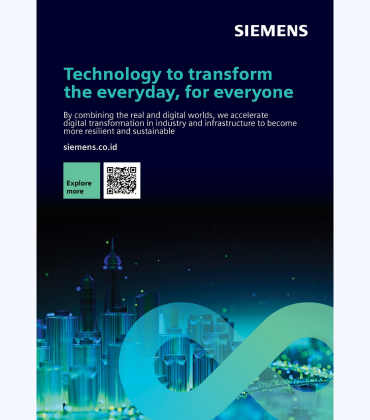With a population of about 264 million, Indonesia is a promising market attracting investments from both domestic and foreign telecommunications companies. The market is further supported by the fact that within the economy, ICT is one of the most prominent sectors with a contribution of more than 3.76% of GDP with a value in excess of USD 39 billion. In addition, Indonesia has become the largest spender on it in Southeast Asia and is ranked 19th globally according to the international data corporation.
The Government of Indonesia has implemented different projects for the ICT industry in the framework of the Indonesian Broadband Plan (IBP) - an operational policy document to develop the Indonesian broadband sector with the goal of increasing the citizens’ welfare. The IBP has planned Internet connectivity with the ability to send voice, images and data at one time (triple-play) with a minimum speed of 2Mbps for fixed network and 1Mbps for mobile access. The flagship initiative of the IBP, the “Palapa Ring”, is an initiative to foster the fiber connectivity between islands in Indonesia.
Parallel with the development of ICT infrastructure, new e-services platforms are being implemented in the financial sector. However, the lack of complete network integration and relatively unstable infrastructure are impeding e-services players to retain their prospective customers. The e-commerce sector offers great potential, not only within the context of the success of the industry in mature markets, but due to the key advantages that it offers to a market such as Indonesia. Infrastructure and logistical constraints in Jakarta, secondary cities and outlying islands make online shopping an ideal and convenient alternative by providing access to goods that are not available in the immediate vicinity of many consumers.
Overall, it is expected that with the market size, Internet penetration growth, new consumption patterns and strategic position in ASEAN, Indonesia will continue to attract global players especially in the e-commerce, e-logistics, financial services sectors as well as security services.
HIGHLIGHTS
In 2019, 56% of the population are active internet users (150 million), 95% of which are active mobile internet users. Some 91% of the adult population are equipped with a mobile phone, 60% of whom are smartphone owners. Since 2014, the number of Internet users in Indonesia has increased dramatically. In 2014, only 14% of the adult population owned a smartphone
In 2019, the ministry of Communication finally started the long-awaited reframing of its 800MHz and 900MHz spectrum to make 4G LTE available nationwide through Ministerial Regulation No. 29/2019. The allocation of lower frequency (below 700 MHz) to mobile broadband could provide high speed internet access in rural and remote areas, increasing mobile internet customers from 102 million in 2017 (39% penetration) to 185 million (65% penetration) in 2025.
E-Services Market Forecast 2019 - 2023
| Segments | 2019 | 2023 | CAGR | |
| Revenue value (USD million) |
Users (in million) |
Revenue value (USD million) |
||
| Online Food Delivery | 1.340 | 38,7 | 2.135 | 10,5 |
| Event tickets | 362 | 29,7 | 665 | 16,4 |
| Fitness | 147 | 23,8 | 186 | 6 |
| Dating Services | 33 | 10,9 | 41 | 5,3 |
Source: Compiled by EIBN, Statista, 2019
In 2019 e-services market amounts to USD 1,891 revenue and is forecast to reach more than USD 3 billion by 2023. The largest segment being online food delivery which already exceeds $1 billion in the country, primarily driven by the explosive growth of GoFood. Other segments are expected to grow including event tickets, fitness and dating services.
Smart Home Market Forecast 2019 - 2023
| Sub segment | Revenue value (USD million) |
Houshold penetration % | CAGR 2019-2023 | Key examples |
| Energy management | 40 | 1,4 | 46,8 | automated temperature control and times, connected sensors |
| Comfort and Lighting | 162 | 4,2 | 53 | smart bulbs, door and window sensors, garage door controls |
| Control and connectivity | 257 | 5,9 | 50,3 | smart speakers, communication hub, programmable control button smart plugs |
| Security | 211 | 2,2 | 42,9 | surveillance products, connected smoke detectores humidity sensors |
| Smart Appliances | 592 | 4,8 | 47,8 | large and small house appliances connected to internet |
| Home entertainment | 152 | 2,2 | 40,4 | streaming devices, multiroom entertainment |
Source: Compiled by EIBN, Statista, 20189
In the coming years smart home appliances and connected cars will grow at a rapid pace. In 2019 the smart home market generated USD 303 million with only a million smart homes. By 2023, expected to grow at 47.1% CAGR and generate USD 1,415 billion revenues. Growth will be driven by smart appliances, control and connectivity and security sub segments.
Cybersecurity Spending (% of GDP) - 2017
Source: A.T Kearnbey, 2018
In 2017, 0.02% of Indonesian’s GDP was allocated to cybersecurity below global average and ASEAN Average. Indonesia’s cybersecurity is USD 24 billion below mature market average. Indonesia stands out and require significant investment in cyber security as the share of its digital economy grows. Indonesia, as are most ASEAN countries, focuses on services in the cybersecurity value chain.
CONCLUSION
ICT development in Indonesia is seen as the beginning of a more promising period. Indeed, much of its potential is in fact still to be unleashed, rendering Indonesia as one of the most promising ICT markets in the coming years.
The market potential for providing with ICT services in Indonesia is expected to reach US$78 billion from 2019 through 2022. According to APIJJ 2017 survey, there is a growth demand for digital content applications and business solutions. The growth in internet traffic and generated data increased the need for IT services in the field of network security, data center management and cloud service management. Software, IT and telecommunications have taken significant places in Indonesia’s economy and 60% of Indonesia’s GDP will be digitalized by 2022.
Indonesia is entering the era of the industrial internet, which provides opportunities for businesses to thrive in the fields of IT, software and telecommunications in the form of direct investment, partnership ventures, technology export, consulting and training. However, European companies are strongly advised to invest time and effort in finding a good and reliable local partner, as serving the Indonesian market requires cooperating with an Indonesian agent and/or distributor. Beyond the market entry, a local partner can offer valuable know-how to in terms of negotiating with potential domestic clients.
Advices to ICT companies exploring the Indonesian market:
- Culture adoption - understand the local business characteristics, need to think realistic, long term and flexible on business models
- Find reliable local business partners through channels such as chambers of commerce and trade agencies.
- The market is very price-sensitive, especially with intense competition with Chinese, Korean, Japanese and American companies, worldwide leaders in the ICT market
- Participate in major trade exhibitions and showcase products/services to the relevant audiences to build connections and in-depth knowledge.
- Participate in a pan-European Trade Mission or work with the present chambers of commerce to find the right partner and assist you in navigating the Indonesian market.
This content is in collaboration with
Business Sectors



